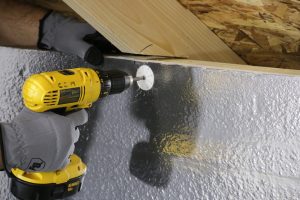As the sun comes out and the flowers start to emerge from their winter sleep, your thoughts may be turning to the long list of home improvement projects that have stacked up over the cold, dark months. Adding expanded polystyrene (EPS) insulation to your attic, basement or garage can generally be done in a weekend, and offers increased energy and cost-saving benefits. This makes it an ideal project, but how do you choose the right solution and the right products for your space and needs?
Why EPS is best for your project
While multiple options for home insulation exist, EPS is a great choice because it offers high strength and high R-value per dollar, along with several other benefits.
EPS insulation is generally easier to work with for the DIY installer, especially compared to blown-in or fiberglass batts. EPS insulation — such as Insulfoam R-Tech — can be cut with common household tools like a razor knife or reciprocating saw. Unlike blown-in insulation, it won’t settle. And, because it is lightweight and won’t litter your arms with fiberglass strands, it can be moved and installed by one person (or with the young helpers we often have on the weekends).
EPS insulation is inert, does not emit undesirable gases and is reusable or recyclable. EPS insulation also resists rot and decay because of its low moisture retention rates. For the DIYer, EPS insulation is an easy choice. But, how do you choose the right piece or specific panel that best fits your needs?
Reducing overhead in the attic
For the attic, 4×8 foot panels are a go-to for the DIYer because they are offered in four different thicknesses with a variety of R-values. These panels are available at most home improvement stores such as Home Depot or Lowe’s. Installing these panels is a straightforward process. Simply make any necessary custom cuts and then secure the panels into place with a cap nail or screw. A full installation guide for attic installation is available here.
Kits to seal the garage door
One of the quickest projects to improve a home’s energy performance is to add insulation to the garage. In fact, the garage door is generally the largest uninsulated surface of a house. Adding R-Tech insulation panels can help shore up this energy drain and requires minimal tools or experience to do so. Insulfoam offers pre-configured kits to insulate your garage door that include all the materials needed, including pre-cut panels that attach to the inside of your garage door.
EPS insulation below grade and in your basement
For the basement or crawl space, adding extra insulation can be just as impactful to your home’s performance. In addition to its insulating benefits, Insulfoam R-Tech insulation panels provide a surface that is virtually impervious to moisture. It also does not sustain mold and mildew growth, unlike other insulation choices such as fiberglass batt. The benefits of R-Tech make it a great solution for unfinished basements or even against the foundation of a home. If you want to keep that heat in, we’ve shared some installation tips for adding insulation to an unfinished basement in this guide.
For the DIYer and weekend warrior in all of us, it can be hard to choose where to start on that long list of home improvement projects. But if projects that can contribute up to a 10% reduction in your utility costs are at the top of your list, Insulfoam is the perfect fit.

